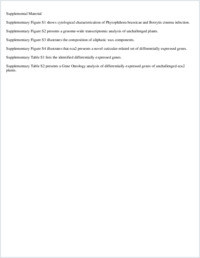The cuticle mutant eca2 modifies plant defense responses to biotrophic and necrotrophic pathogens and herbivory insects
- Blanc, Catherine Department of Biology, University of Fribourg, Switzerland
- Coluccia, Fania Department of Biology, University of Fribourg, Switzerland
- L'Haridon, Floriane Department of Biology, University of Fribourg, Switzerland
- Torres, Martha Centro de Ciencias Genómicas, Universidad Nacional Autónoma de México, Cuernavaca, Morelos, México
- Ortiz-Berrocal, Marlene Centro de Ciencias Genómicas, Universidad Nacional Autónoma de México, Cuernavaca, Morelos, México - Department of Plant Molecular Biology, University of Lausanne, Switzerland
- Stahl, Elia Department of Plant Molecular Biology, University of Lausanne, Switzerland
- Reymond, Philippe Department of Plant Molecular Biology, University of Lausanne, Switzerland
- Schreiber, Lukas Institute of Cellular and Molecular Botany, Department of Ecophysiology, University of Bonn, Germany
- Nawrath, Christiane Department of Plant Molecular Biology, University of Lausanne, Switzerland
- Métraux, Jean-Pierre Department of Biology, University of Fribourg, Switzerland
- Serrano, Mario Centro de Ciencias Genómicas, Universidad Nacional Autónoma de México, Cuernavaca, Morelos, México
-
13.11.2017
Published in:
- Molecular Plant-Microbe Interactions. - 2017, vol. 31, no. 3, p. 344–355
English
We isolated previously several Arabidopsis thaliana mutants with constitutive expression of the early microbe-associated molecular pattern–induced gene ATL2, named eca (expresión constitutiva de ATL2). Here, we further explored the interaction of eca mutants with pest and pathogens. Of all eca mutants, eca2 was more resistant to a fungal pathogen (Botrytis cinerea) and a bacterial pathogen (Pseudomonas syringae) as well as to a generalist herbivorous insect (Spodoptera littoralis). Permeability of the cuticle is increased in eca2; chemical characterization shows that eca2 has a significant reduction of both cuticular wax and cutin. Additionally, we determined that eca2 did not display a similar compensatory transcriptional response, compared with a previously characterized cuticular mutant, and that resistance to B. cinerea is mediated by the priming of the early and late induced defense responses, including salicylic acid– and jasmonic acid–induced genes. These results suggest that ECA2-dependent responses are involved in the nonhost defense mechanism against biotrophic and necrotrophic pathogens and against a generalist insect by modulation and priming of innate immunity and late defense responses. Making eca2 an interesting model to characterize the molecular basis for plant defenses against different biotic interactions and to study the initial events that take place in the cuticle surface of the aerial organs.
- Faculty
- Faculté des sciences et de médecine
- Department
- Département de Biologie
- Language
-
- English
- Classification
- Biological sciences
- License
- License undefined
- Identifiers
-
- RERO DOC 309094
- DOI 10.1094/MPMI-07-17-0181-R
- Persistent URL
- https://folia.unifr.ch/unifr/documents/306700
Other files
Statistics
Document views: 77
File downloads:
- har_cme.pdf: 154
- har_cme_sm.pdf: 99

